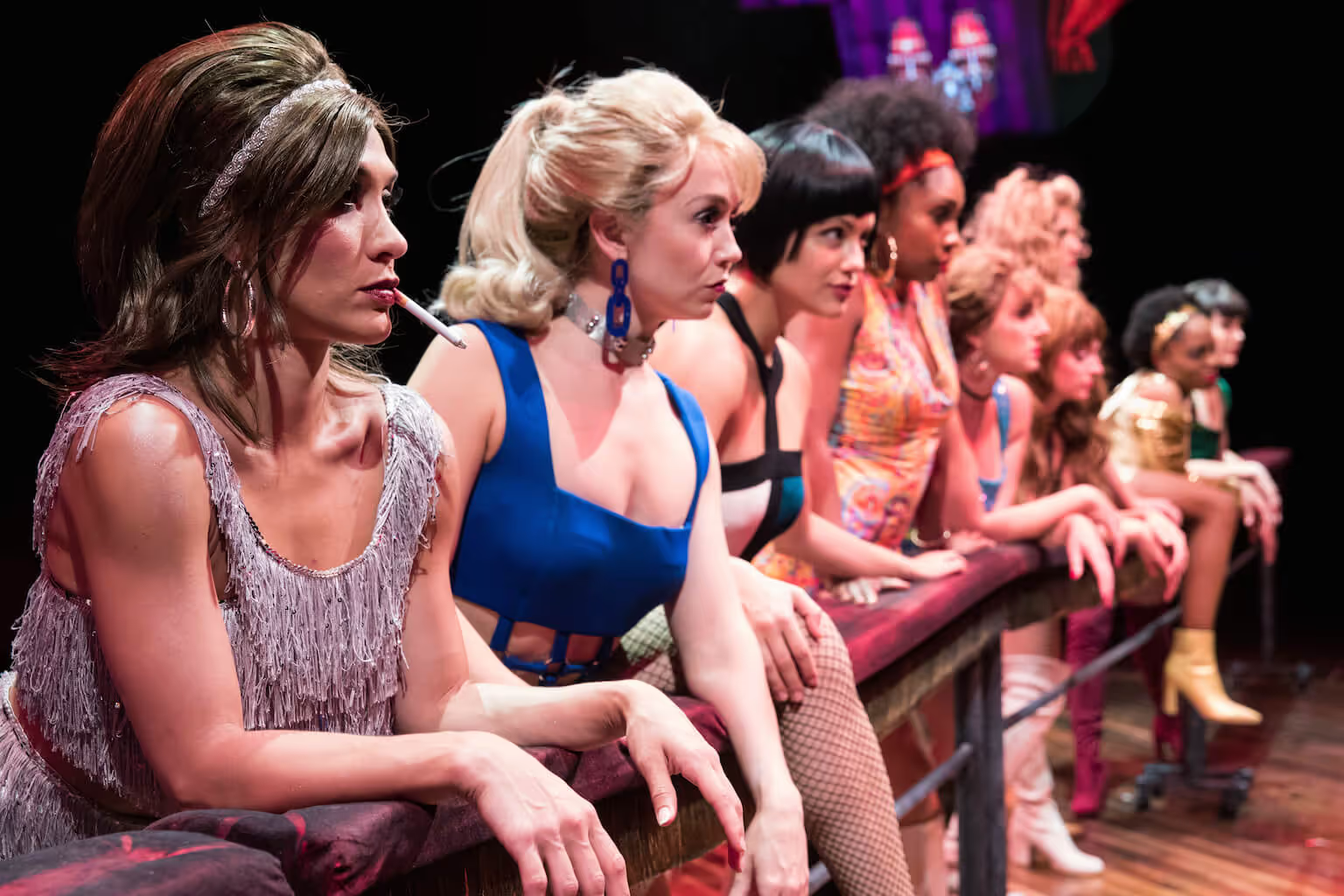Sweet Charity
★★★
“Sweet Charity” rises or falls on the success of a singer-dancer-actress in the starring role and the skills of the director-choreographer. The 1966 Broadway hit was carried by Gwen Verdon in the title role and the dances created by her (then) husband Bob Fosse.
The Marriott Theatre‘s revival of the musical features Anne Horak as the title character and Alex Sanchez as the production’s choreographer and director. Even though Horak is slightly miscast, she delivers big time in an exhausting role. Sanchez does his part with a series of outstanding dance numbers, but the show really profits from the work of Alex Goodrich, who plays a character who doesn’t even appear until the first act is almost over.
Horak plays Charity Hope Valentine, a dance hall hostess in a New York City ballroom (the term “hostess” may or may not be a synonym in the show for a sexual working girl). Charity is a warm, naïve woman who is a pushover for every male chiseler, grifter, moocher, and sponger who crosses her path. Occupationally, she solicits dance partners at the Fandango Ballroom in New York City. She aches for love and marriage but can’t catch a break in her choice of menfolk.
The show is basically a series of set pieces rather than a coherent narrative (the book was written by the recently deceased Neil Simon, not one of his finer efforts). We watch Charity buffeted by faithless men, a plucky girl who never gives up in her search for the decent guy who can take her away from her tacky life (“I have so much love to give.”)
The story ignites with the appearance of Alex Goodrich who plays the neurotic Oscar Lindquist, a man Charity gets to know when they are trapped in a stalled elevator. He may finally be the answer to Charity’s dream of love and stability in her life. In every production I’ve seen of “Sweet Charity,” Oscar is played for low comedy laughs, his claustrophobia in the elevator a series of increasingly over the top panic riffs. Goodrich is really funny and really creative in the extended scene, a marvel of vocal and physical comedy I never thought possible in such an apparently cartoonish role.
Oscar and Charity almost make it down the marriage aisle, but alas, Charity is disappointed again. The show takes a risk with its downer ending, especially because the audience roots for Charity to finally get the man she deserves. But the ending is preserved from the musical’s original source, Federico Fellini’s motion picture “The Nights of Cabiria.” The film ends with our heroine dumped again, though in both the movies and the musical she bites the bullet and soldiers on, her stiff upper lip once more in place, ready again to go out into an unfair world and give it another try.
Horak is a first rate performer, especially as a dancer, but she presents as a wholesome, fetching quality that doesn’t mesh with a Charity who has taken plenty of life’s hard knocks. Horak would be perfect in a prom queen role in “Legally Blonde.” Her Charity is a little too clean cut and attractive.
Dani Spieler and Natonia Monet capture the sleaze of the dancehall grind as Charity’s best friends. Their duet “There’s Gotta Be Something Better than This” portrays the desperation of two women trapped in a lifestyle they despise but can’t escape.
Sanchez has collected a large chorus to carry out his athletic and inventive hoofing. His choreography for the Horak-led “I’m a Brass Band” is the gem of a night filled with colorful high velocity dancing.
The production provides a bonus in the appearance of Kenny Ingram, a Chicagoland favorite from the 1980’s and 1990’s who left for a long and profitable career in “The Lion King.” He leads the exuberant pop gospel production number “The Rhythm of Life” with the style and charisma we enjoyed so often locally before he left town. The number has nothing to do with the main narrative but who cares when we are treated to a scene of prime Ingram sizzle.
Adam Jacobs and Alexandra Palkovic play an Italian movie star and his temperamental mistress, a couple who improbably cross Charity’s path for one star-struck night. Terry Hamilton plays the dance hall’s hardboiled manager, a minor role but he does get to sing “I Love to Cry at Wedding,” a sappy song that doesn’t deserve to be the show’s near closing number.
The score has a handful of solid songs by Cy Coleman (music) and Dorothy Fields (lyrics). Probably the most familiar is “Big Spender,” a cynical siren invitation by the Fandango girls to entice male clients to spend their money to dance, and maybe more. There are also catchy numbers like “If My Friends Could See Me Now,” “I’m a Brass Band,” and “There’s Gotta Be Something Better Than This.”
The set design by Scott Davis is basically an open stage with appropriate props carried on and off during entertaining scene changes by the chorus. The set is garnished with Jesse Klug’s multi-colored lighting and Anthony Churchill’s video design. Mieka van der Ploeg designed the flashy costumes and Robert Gilmartin designed the sound plan. Sally Zack is credited with the properties design, topped by the gaudy vehicle operated by two hippies as Ingram presides in “The Rhythm of Life.” The Marriott pit orchestra, led by Patti Garwood, provides outstanding high stepping musical accompaniment.
The Marriott revival reinforces Alex Sanchez as one of the hot choreographer directors in Chicagoland theater. His choreography elevates the so-so musical” into an exhilarating evening when the dancers take over. I may be shortchanging the talented Anne Horak, penalizing her for being too attractive for the role. When she joins the chorus in the production numbers, the stage lights up. And the contributions of Alex Goodrich cannot be overestimated.











